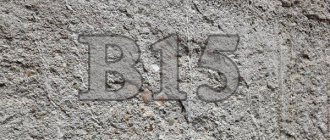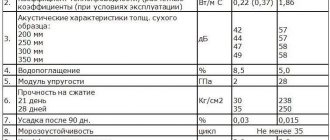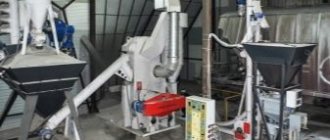Concrete is a load-bearing structural material of buildings and structures. Therefore, its technical characteristics must comply with the requirements of regulatory documents - GOST and SNiP. To check the compliance of the material with the declared brand, concrete is tested for: compression, bending, tension, frost resistance and a number of other indicators on which the durability and load-bearing capacity of concrete products, structures and buildings depend.
Based on the results of the tests, a special document is drawn up, the so-called “Material Quality Passport”, the official name is “Document on the quality of the concrete mixture”, created based on the results of laboratory tests of concrete at the manufacturer. This is the main official document that guides construction organizations when constructing critical and special concrete structures.
Concrete compressive strength test
The test gives an idea of all the characteristics of concrete.
This single test is used to judge whether concreting has been done correctly or not. Our discounts and promotions
The compressive strength of concrete for general construction ranges from 15 MPa (1000 kg per square inch) to 30 MPa (2000 kg per square inch) and higher in commercial and industrial structures.
The compressive strength of concrete depends on many factors such as water-cement ratio, cement strength, quality of concrete material, quality control during concrete production, etc.
The compressive strength test is carried out on either a cube or a cylinder.
Various standard codes recommend a concrete cylinder or concrete cube as the standard test specimen.
Classification of test methods, stages of implementation
During the construction process, the concrete base is checked in a state of unhardened mass and in a frozen form. The choice of concrete testing methods depends on the year of construction and operation of the structure, the equipment used, and the initial data.
In liquid form, the mixture is examined after mixing the mortar. This is necessary to determine technological indicators.
The following algorithms are carried out:
- checking the compaction coefficient;
- cone draft. Determines the indicator of homogeneity of the structure and its consistency;
- change in the plasticity of the material;
- presence or absence of voids.
In private development, surface inspection is used. This empirically allows us to evaluate the quality of work.
Signs of good concrete:
- thick “milk” on top of the base;
- color: gray with a greenish tint. Yellow is a bad sign;
- the solution covers all fractions of the filler;
- After hitting the structure, the steel hammer bounces back with a ringing sound.
The hardened concrete mixture is affected by other methods.
Destructive methods
Concrete sampling at a construction site (GOST 28570-90) is carried out by cutting a sample using diamond drills from a frozen monolith. In the second option, the mixture is cast in the laboratory in the shape of a cone, cube, or cylinder. The material is subjected to increasing pressure (compression) with the moment of the beginning of destruction being recorded.
Additional Information! The technology is used in the construction of important buildings. A protocol is drawn up indicating the date of the event.
Non-destructive direct methods
Tools or devices that can reveal the properties of a concrete solution without damaging the structure or individual specimen will help to examine the base. The interaction occurs mechanically through:
- separation A piece of steel is attached to the monolithic structure with epoxy glue, which is abruptly torn off together with a fragment of the concrete base using the GPNI-5 device. The applied force is converted into a coefficient through the formula;
- separation with chipping. The device should be installed in the concrete cavity using special anchors, and then they will remove part of the hardened cement;
- chipping ribs. Used on surfaces with protruding corners. GPNS-4 is attached to the protrusion and is gradually loaded.
Important! This technique is not used on substrates where the protective layer does not exceed 2 cm.
Non-destructive indirect methods
Determining the strength of concrete can be done without the labor-intensive process of drilling and installing the device into the base of the structure. An example is acoustic devices. Their error is about 5%.
There are different effects to determine the grade of material:
- shock impulse. A piezoelectric device converts energy from the striker on the surface of the base into electric current;
- ultrasound. The UGV-1 device compares the speed of wave propagation in the standard model and the frozen monolith;
- plastic deformation. Kashkarov's hammer delivers a series of blows to the frozen structure. Then the traces on the concrete are measured and compared with reference samples;
- elastic rebound. The sclerometer records the amount of reverse movement of the striker after contact with the wall. This is how the hardness of the material is examined.
This tactic is more accessible to use. But factors leading to data distortion should be eliminated whenever possible.
Determination of compressive strength
Compressive strength is the ability of a material or structure to withstand loads on its surface without any cracks or deflections. When compressed, a material tends to shrink in size, and when stretched, the size tends to elongate.
Compressive Strength Formula
The formula for compressive strength for any material is the load applied at the point of failure to the cross-sectional area of the surface on which the load was applied.
Compressive strength = load / cross-sectional area
Determination of strength without destruction of concrete
Among non-destructive methods for determining strength values, ultrasonic testing of concrete is considered the most popular. The method is based on changing the speed of passage of ultrasonic waves through the thickness of the material.
Modern devices for ultrasonic testing of concrete are “indicating”, that is, during testing they display a strength indicator in the required units. The main disadvantage of “ultrasonic” technology is the significant measurement error.
- Tensile and bending testing of concrete. The testing technology is similar to the technology for testing concrete samples for strength. The main difference between tensile testing and bending testing is the vector of application of the breaking load. When testing for strength, samples are “pressed” with a vertical load, and when testing for tension and bending, they are destroyed by horizontal and “cantilever” force.
- Testing concrete for frost resistance. The frost resistance of concrete is measured in the number of “freezing-thawing” cycles that the structure can withstand before destruction begins. This value also refers to the main technical characteristics on which the durability of the structure depends. The technology for testing frost resistance involves freezing and thawing control samples in laboratory conditions, after which a comparative analysis of the loss of strength is carried out and a corresponding determination of the value of frost resistance.
Concrete strength testing method
Two types of samples are used for cube testing: cubes measuring 15 cm × 15 cm × 15 cm or 10 cm × 10 cm × 10 cm, depending on the size of the aggregate. For most projects, cubic molds measuring 15 cm x 15 cm x 15 cm are usually used.
This concrete is poured into a mold and hardened properly so that there are no voids. After 24 hours, these molds are removed and test specimens are placed in water to cure. The top surface of these samples should be flat and smooth. This is done by applying cement paste and spreading it evenly over the entire area of the sample.
These samples are tested on a compression press after 7 days of soaking and curing or 28 days of curing. The load should be applied gradually at a rate of 140 kg/cm2 per minute until the specimens fail. The load received at failure divided by the area of the specimen gives the compressive strength of the concrete.
Compressive strength = load / cross-sectional area
Scheme B or Scheme D and what is it?
So, what are schemes B and D and what is their fundamental difference. Scheme B and Scheme D are schemes (sequence of actions) according to which control and determination of the actual class of concrete in a structure is carried out. A description of the schemes in relation to monolithic structures is given in clause 4.8. The main difference between the schemes is that according to scheme B, the coefficient of variation in the strength of concrete Vm in the controlled batch is calculated, taking into account the error of the non-destructive methods used in determining the strength. According to scheme D, the coefficient of variation is not calculated.
What is the coefficient of variation for? The coefficient of variation characterizes the spread of concrete strength readings in controlled areas in a structure and is necessary when determining the actual class of concrete in a structure. For monolithic structures, the actual class of concrete is determined by the formula Vf = Rm/Kt, where Rm is the actual average strength of concrete of a separate batch, MPa, Kt is the required strength coefficient taken from Table 2. The table shows that the lower the coefficient of variation, the lower the coefficient required strength, the greater will be the value of the actual concrete class. To put it simply, the more constant the measured strength readings are, the better and higher quality the concrete is and the less safety margin is needed to not go beyond the concrete class required by the project. Let us explain that in general, the strength of concrete is divided into classes B3.5; AT 5; B7.5; AT 10 O'CLOCK; B12.5; B15; IN 20; B22.5; B25; B27.5; B30; B35; B40, etc. The number next to the letter B means the MPa load that concrete can withstand when crushing a sample cube of 150×150×150 mm, for example B20 means that a concrete cube of 150×150×150 mm can withstand a load of 20 MPa. Since it is impossible to produce concrete, much less a monolithic structure with constant strength in each section and each batch, therefore, a coefficient of required strength is introduced, which depends on the coefficient of variation of the strength measurements made and, taking into account which, it can be guaranteed that the strength of concrete in a separate section of the structure is not will be less than the strength of the design class of concrete.
From all of the above, it is quite logical to conclude that when monitoring the strength of concrete in a monolithic structure, it is necessary to use scheme B, which, in addition to the actual average strength of the concrete of the batch, also takes into account the actual coefficient of variation of the measured strength, however, there are several BUT...
Looking at paragraph 6, we see that calculating the coefficient of variation is by no means a simple task and requires significant calculations, but this is not so bad. The main snag lies in the requirement of clause 5.8 “The total number of measurement sections for calculating the uniformity characteristics of the concrete strength of a batch of structures must be at least 20”, in clause 5.5 “...control of concrete strength by indirect non-destructive methods is carried out with the mandatory use of calibration dependencies previously established in in accordance with the requirements of GOST 22690 and GOST 17624...", as well as in clause 8.2 of GOST 22690-2015 "Statistical assessment of the class of concrete based on test results is carried out according to GOST 18105 (schemes A, B or C) in cases where the strength of concrete is determined by calibration dependence constructed in accordance with Section 6. When using previously established dependencies by linking them (according to Appendix G), statistical control is not allowed, and the concrete class is assessed only according to scheme G...”
Let us explain that indirect methods of non-destructive testing include:
- ultrasonic method;
- rebound method;
- shock pulse method;
- all simple and quick methods with which you can easily and quickly determine the strength of concrete.
all simple and quick methods with which you can easily and quickly determine the strength of concrete.
A direct non-destructive testing method is the peel-off method.
Thus, in order to control the strength of concrete of a monolithic structure according to scheme B, it is necessary either to carry out all tests (at least 20 for one batch) by the tear-off method, or to first calibrate indirect methods for a given batch of concrete, which again requires at least 12 parallel tests using the indirect method and the peeling method (in this case, the procedure will have to be carried out for each new batch of concrete) and in both cases, carrying out such tests requires significant costs and will negatively affect the appearance (and often the strength characteristics) of the structure , taking into account the required number of measurements using the peel-off method.
The only applicable and least expensive way to control the strength of concrete remains testing according to scheme D without taking into account the actual coefficient of variation. The actual class of concrete is calculated using the formula Vf=0.8*Rm. Thus, the necessary margin of variation in concrete strength is provided.
It is worth noting that in the case of tests according to scheme D, it will still not be possible to avoid the peeling method. It is necessary to carry out the procedure for linking a universal calibration relationship (usually indicated in the instrument passport or in other regulatory documentation for the control method) to the controlled batch of concrete by conducting at least three parallel tests using the indirect method and the peel-off method and calculating the coincidence coefficient Kc according to Appendix G GOST 22690 -2015, by which all measured strength values will be multiplied.
It should also be understood that when assessing the class of concrete according to scheme D, the required value of concrete strength is overestimated, since plants usually supply concrete according to design scheme A with a coefficient of variation of 7-10% for which Kt varies from 1.08 to 1.14, for scheme G Kt = 1.28, thus the required strength of the concrete of the plant will automatically be lower than the required strength of the structure obtained from testing according to scheme G.
Let's give an example: the plant supplied concrete to the site according to scheme A class B20 with a strength variation coefficient of 10%, the required strength of such concrete Rt = Kt * Vnorm = 1.14 * 20 = 22.8 MPa (accordingly, the actual strength values at the design age at proper installation and maintenance of concrete will be close to this figure), however, the required strength when controlled according to scheme D will be higher Rt=Kt*Vnorm=1.28*20=25.6 MPa.
Therefore, we strongly recommend that builders negotiate with the plant the scheme according to which concrete is supplied. This will allow you to avoid re-grading concrete and smooth out flaws in the placement and hardening of concrete (usually concrete according to scheme D is supplied with a significant margin of safety).
Procedure for testing the strength of concrete cubes
You will need:
Compression Testing Machine Test Laboratory Press
Preparation of a specific cubic sample
The proportion and material used to make these test specimens are from the same concrete used in the construction of the facility in the field.
Sample for making concrete cubes
Need 6 samples of cubes 15 * 15 cm
Mixing concrete for cube testing
Mix concrete by hand or in a laboratory mixer
Manual mixing
- Mix the cement and fine aggregate on a waterproof, non-absorbent platform until the mixture is thoroughly mixed and uniform in color.
- Add coarse aggregate and mix with cement and fine aggregate until coarse aggregate is evenly distributed throughout the batch.
- Add water and mix until the concrete is smooth and reaches the desired consistency.
Preparing cubes for dough
- Clean the bumps and apply oil
- Pour concrete into the molds in layers about 5 cm thick.
- Compact each layer using at least 35 blows per layer using a tamping tool
- Level the top surface, level it with a spatula
Test specimens are stored in humid air for 24 hours and after this period the specimens are marked, removed from the molds and stored in clean fresh water until removed for testing.
Concrete strength grades and their scope of application
To determine the characteristics of concrete, it is given a marking according to GOST: the letter M and a number indicating the compressive strength of the material. The higher the value, the more durable the product made from this material is - the strength depends on the amount of cement in the mixture.
According to its strength characteristics, concrete is divided into grades from M100 to M500 in increments of 50. Another characteristic, the concrete class, determines the ability of the material to work in aggressive environments.
Concrete grades M100, M150, M200 and M250 are classified as light and cellular. They are used for pouring structures that do not bear a significant load. They are used for constructing curbs, foundations for small buildings, and pedestrian paths.
Concrete M300 and M350 can be used for casting floor slabs, constructing foundations in multi-story construction, and casting monolithic walls.
The most durable concrete grades, M400, M450 and M500, are used in the production of reinforced concrete structures operating in difficult conditions with increased load (for example, for the construction of hydraulic structures).
Procedure for testing a concrete cube
- Remove the sample from the water after the specified curing time and wipe off excess water from the surface.
- Clean the surface of the testing machine
- Place the sample in the machine so that the load is applied to opposite sides of the cast cube.
- Center the sample on the machine base plate.
- Gently rotate the moving part by hand until it touches the top surface of the sample.
- Apply the load gradually, without impact and continuously, at a rate of 140 kg/cm2/min until the specimen fails
- Record the maximum load and note any unusual features at failure.
Notes:
A minimum of three samples must be tested at each set age selected.
If the strength of any sample varies by more than 15 percent of the average strength, the results of such testing should be considered invalid. The average of three samples gives the crushing strength of concrete. And shows compliance with the requirements for concrete strength.
What does the strength of concrete depend on and what influences it?
The ability of concrete to resist external influences due to internal stress depends on the composition of the solution and the brand of cement. When confirming the strength of a material corresponding to a certain brand, the sample should not show signs of destruction in the form of chips, cracks, or delamination of the structure.
Sometimes builders, when carrying out work, try to save on materials by using cheaper, low-grade concrete, but violating the design values can lead to serious consequences, so such a means of saving is unacceptable.
In addition to the ratio of filler and cement, the strength of the composition is influenced by additives and plasticizers used to give the product special properties (acid resistance, water resistance, speed of rise, plasticity). To obtain structures that can withstand high loads, it is mandatory to reinforce the elements with metal wire of various sections.
In addition to the composition of the solution, the strength of concrete is influenced by the external conditions under which the pouring is carried out. With high-quality removal of air bubbles from the concrete mass by compacting the mixture, the strength of the products increases noticeably.
It should also be taken into account that when using a solution at subzero temperatures, measures should be taken to heat the material by installing electrodes in the fill and connecting electricity to them. In such a situation, covering the base with sawdust is also used.
When working with concrete, it is important to maintain the necessary humidity to prevent cracking of the pouring surface due to rapid evaporation of moisture, which also affects the quality of the material and its strength. To avoid this process, it is necessary to cover the concrete with film or other available means, and also periodically moisten the surface.
As a result, it can be argued that the strength of concrete depends on many factors, and therefore quality control is especially important when installing load-bearing structures, since even if the technological processes are fully followed, there can always be factors that will affect the concrete and cause problems in the future .
Compressive strength of concrete at different ages, when testing the strength of concrete
The strength of concrete increases with age.
The table shows the strength of concrete at different ages compared to the strength 28 days after pouring - not suitable for testing the strength of concrete.
| Age | Power percentage |
| 1 day | 16% |
| 3 days | 40% |
| 7 days | 65% |
| 14 days | 90% |
| 28 days | 99% |
Cubes or non-destructive testing methods?
So, what is the best way to control the strength of concrete?
Many builders, in the old-fashioned way, when carrying out concrete work, take samples (concrete is poured into special forms of 100×100×100 mm or 150×150×150 mm), the poured cubes are stored on site or under normal conditions in the laboratory (and, often, not many people know how exactly the cubes need to be filled and in what conditions they should be stored) and tested at intermediate (7 days) or design (28 days) age. What does GOST 18105-2010 say to this? According to clause 4.3, concrete strength control is carried out according to one of four schemes A, B, C or D. According to 4.4. for monolithic structures, strength control is carried out according to schemes B or D, which imply the use of non-destructive testing methods (see clause 4.8). However, the note in clause 4.3 states that - “in exceptional cases (if it is impossible to carry out continuous monitoring of the strength of concrete of monolithic structures using non-destructive methods), it is allowed to determine the strength of concrete using control samples made at the construction site and hardened in accordance with the requirements of 5.4, or based on control samples selected from structures...". Thus, monitoring the strength of concrete in monolithic structures must be carried out using non-destructive testing methods. And only in exceptional cases, when the structure is immediately closed or buried and there is no access to the concrete of the structure at an intermediate and control age, the strength is determined using control samples (cubes), and the cubes must be stored on site, in the same conditions as the structure itself (p 5.4).
Also, pouring the cubes is possible during the incoming inspection of a batch of ready-mixed concrete (concrete mix) delivered to the construction site; in this case, the concrete cubes must be stored under normal conditions at a temperature of (20±3)°C and relative humidity (95±5)%.
Compressive strength of concrete at 7 and 28 days
| Concrete grade | Minimum compressive strength N/mm 2 after 7 days | Specified compressive strength characteristic (N/mm2) at 28 days |
| M150 | 10 | 15 |
| M200 | 13,5 | 20 |
| M250 | 17 | 25 |
| M300 | 20 | 30 |
| M350 | +23,5 | 35 |
| M400 | 27 | 40 |
| M450 | 30 | 45 |
Our discounts and promotions










